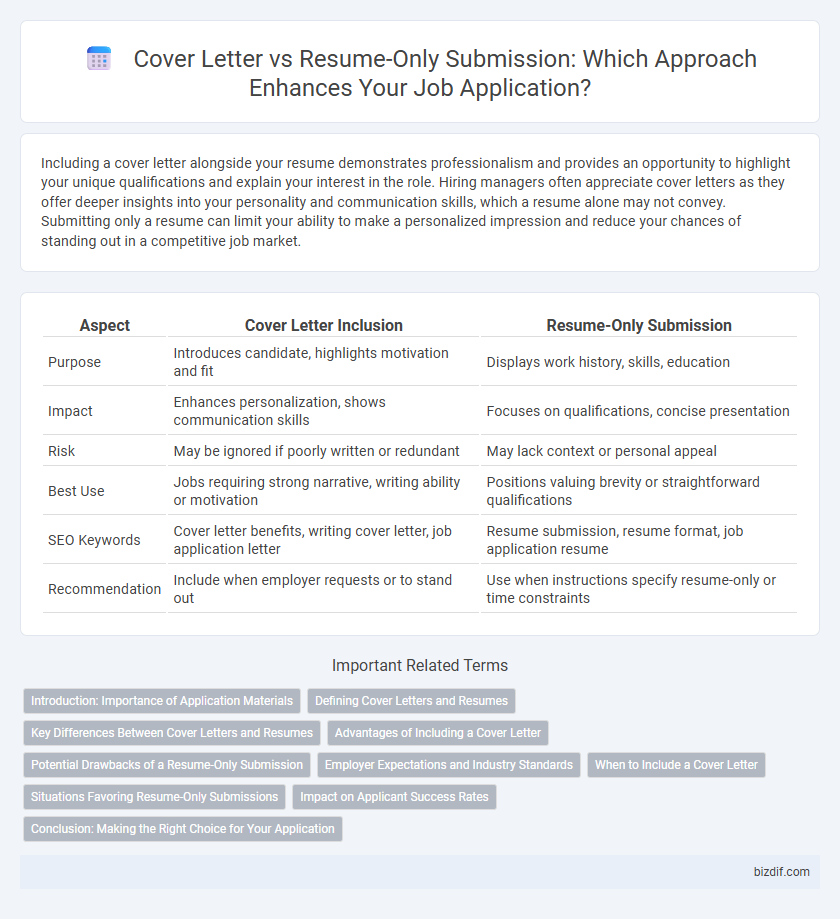Including a cover letter alongside your resume demonstrates professionalism and provides an opportunity to highlight your unique qualifications and explain your interest in the role. Hiring managers often appreciate cover letters as they offer deeper insights into your personality and communication skills, which a resume alone may not convey. Submitting only a resume can limit your ability to make a personalized impression and reduce your chances of standing out in a competitive job market.
Table of Comparison
| Aspect | Cover Letter Inclusion | Resume-Only Submission |
|---|---|---|
| Purpose | Introduces candidate, highlights motivation and fit | Displays work history, skills, education |
| Impact | Enhances personalization, shows communication skills | Focuses on qualifications, concise presentation |
| Risk | May be ignored if poorly written or redundant | May lack context or personal appeal |
| Best Use | Jobs requiring strong narrative, writing ability or motivation | Positions valuing brevity or straightforward qualifications |
| SEO Keywords | Cover letter benefits, writing cover letter, job application letter | Resume submission, resume format, job application resume |
| Recommendation | Include when employer requests or to stand out | Use when instructions specify resume-only or time constraints |
Introduction: Importance of Application Materials
Cover letters provide a strategic opportunity to highlight relevant skills and explain career motivations, complementing the resume's concise factual data. Employers often use cover letters to assess communication abilities and cultural fit, which are not fully conveyed through resumes alone. Including a tailored cover letter alongside a resume increases the likelihood of catching recruiters' attention and advancing in the hiring process.
Defining Cover Letters and Resumes
Cover letters serve as personalized introductions that highlight a candidate's motivation and suitability for a specific role, complementing the factual overview presented in resumes. Resumes provide structured summaries of work experience, skills, and education, emphasizing quantifiable achievements and professional history. Including a cover letter with a resume can demonstrate communication skills and a tailored interest in the position, potentially increasing chances of securing an interview.
Key Differences Between Cover Letters and Resumes
Cover letters provide a personalized introduction, highlighting specific skills and experiences tailored to the job, whereas resumes offer a concise, structured overview of professional history and qualifications. Cover letters emphasize motivation and cultural fit, allowing applicants to address hiring managers directly, while resumes focus on quantifiable accomplishments and career progression. Including a cover letter can differentiate candidates by showcasing communication skills and a deeper understanding of the role, complementing the factual resume content.
Advantages of Including a Cover Letter
Including a cover letter in your job application provides a personalized platform to highlight relevant skills and experiences that align with the job description, making your resume stand out to hiring managers. It allows you to explain gaps in employment or unique career transitions clearly, offering a narrative that a resume alone cannot convey. Cover letters also demonstrate your genuine interest and motivation for the position, which can increase your chances of securing an interview.
Potential Drawbacks of a Resume-Only Submission
Submitting a resume without a cover letter can limit your ability to showcase personalized motivation and relevant experiences that align with the job description. Employers may perceive a resume-only submission as a lack of effort or genuine interest, potentially reducing your chances of standing out in competitive applicant pools. Omitting a cover letter also restricts the opportunity to address specific qualifications or explain employment gaps, which can be crucial for effective candidate evaluation.
Employer Expectations and Industry Standards
Employers in competitive industries often expect cover letters as a demonstration of genuine interest and tailored communication skills, while some sectors prioritize concise resume-only submissions to streamline applicant reviews. Hiring managers value cover letters that highlight specific achievements and align candidate qualifications with job requirements, enhancing the overall application impact. Industry standards vary, so researching employer preferences and following application instructions carefully improves chances of making a strong first impression.
When to Include a Cover Letter
Including a cover letter is essential when job postings explicitly request one or when applying to positions that emphasize communication skills or cultural fit. A tailored cover letter highlights relevant achievements and explains how your experience aligns with the company's needs, providing context that a resume alone cannot convey. For roles in competitive industries or senior-level positions, a well-crafted cover letter can differentiate you from other candidates and demonstrate genuine interest.
Situations Favoring Resume-Only Submissions
Resume-only submissions are favored in automated application systems where applicant tracking software (ATS) scans primarily for keywords in resumes, reducing the impact of cover letters. Situations with strict word or page limits, such as online job portals specifying resume-only uploads, also prioritize concise resume content. Employers focusing on quantifiable achievements and skills may prefer resumes alone for quicker evaluation and standardization.
Impact on Applicant Success Rates
Including a tailored cover letter increases applicant success rates by providing context and highlighting relevant skills beyond the resume's bullet points. Studies show candidates who submit cover letters alongside resumes have a 25-40% higher interview call-back rate. Recruiters often use cover letters to assess communication abilities and candidate motivation, making them crucial for standing out in competitive job markets.
Conclusion: Making the Right Choice for Your Application
Including a cover letter alongside your resume significantly enhances your application by providing context, showcasing personality, and explaining how your skills align with the job. Research shows recruiters prefer applicants who submit tailored cover letters, increasing interview chances by up to 40%. For competitive roles, prioritizing a well-crafted cover letter with your resume is a strategic decision that maximizes your impact and distinguishes your candidacy.
Cover Letter Inclusion vs Resume-Only Submission Infographic

 bizdif.com
bizdif.com